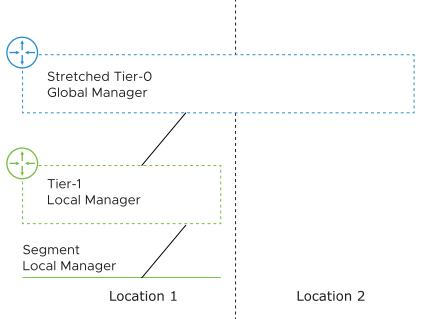In NSX Federation, you make configuration changes on the active Global Manager. The active Global Manager then synchronizes the changes with the relevant Local Managers and the standby Global Manager, if you have one. Local Managers also sync some information with each other and to the Global Manager.
Making Changes on Global Manager
The Global Manager provides a user interface similar to the NSX Manager interface.
If you choose, you can configure all objects on the Global Manager, independent of span.
The Global Manager syncs a configuration with a Local Manager only if the configuration is relevant to that location. For example, if you create a tier-0 gateway and add it to Location 1, Location 2, and Location 3, the configuration gets synchronized with all three Local Managers. Local Managers can only synchronize once with Global Manager during a configuration import.
If you have a standby Global Manager, the configurations synchronize between the active Global Manager and the standby Global Manager.

If the tier-0 gateway is added only to Location 1 and Location 2, the configuration is not synced with Location 3.

Making Changes on Local Managers
To create objects on a specific Local Manager, you use that Local Manager. These objects do not sync with the active Global Manager or any other Local Managers.

Realizing Global Manager Changes on Local Managers
The Global Manager validates change against the Global Manager and the Local Manager configurations. When a Local Manager receives a configuration from the Global Manager, it realizes the configuration in the fabric nodes of that Local Manager. During this realization, errors or conflicts might get detected. To monitor configuration flow, use the NSX Federation monitoring dashboard. See Monitoring NSX Federation Locations for details.
For example, you can create a tier-0 gateway from Global Manager, and then from a Local Manager you can create and attach a tier-1 gateway to the tier-0 gateway.

- The tier-0 gateway might get deleted from the Local Manager in Location 2.
- The tier-0 gateway might get deleted from the Local Manager in Location 1.
- The tier-0 gateway gets marked for deletion on the Global Manager.
- On Global Manager:
GET /global-manager/api/v1/global-infra/realized-state/alarms
- On Local Manager:
GET /policy/api/v1/infra/realized-state/alarms